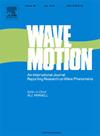声波在带隙和负群速毡型材料中传播的数值研究
IF 2.5
3区 物理与天体物理
Q2 ACOUSTICS
引用次数: 0
摘要
本文对声波在非线性多孔毡状材料中的传播进行了数值研究。采用基于实验得到的本构关系的一维模型方程。进行了色散和耗散分析。研究了带隙(BG)和负群速度(NGV)对波传播的影响。因此,研究了位于BG及其附近和NGV区域的特征宽度与波数相对应的脉冲的传播。如果材料的加载和卸载时间尺度与感觉松弛时间相比太大,则BG和NGV对波形演变的任何可能贡献都可以忽略不计。论文的结论是,毛毡不是具有显著性能的超材料。给出了这些结论的可能原因。可见,正确认识NGV现象将导致非织造纤维毡型材料工程和应用的重大突破。这些应用可能包括振动和噪声控制,甚至波浪操纵。本文章由计算机程序翻译,如有差异,请以英文原文为准。
Numerical investigation into acoustic wave propagation in felt-type material with band gap and negative group velocity
In this paper acoustic wave propagation through nonlinear porous felt-like material is studied numerically. A 1D model equation based on the experimentally obtained constitutive relation is used. A dispersion and dissipation analysis are performed. The possible effects of band gap (BG) and negative group velocity (NGV) on the wave propagation are investigated. For this reason, the propagation of pulses with characteristic widths corresponding to wavenumbers that are located in and near the BG and the region with NGV are studied. It is claimed that if the material loading and unloading timescale is much too great in comparison to the felt relaxation time, then any possible contribution of BG and NGV on the wave shape evolution is negligibly small. Paper concludes that felts are not metamaterials with noteworthy properties. Possible reasons for these conclusions are given. It is obvious that the proper understanding of NGV phenomenon will lead to significant breakthroughs in unwoven fibrous felt-type material engineering and applications. These applications may include vibration and noise control and even wave manipulation.
求助全文
通过发布文献求助,成功后即可免费获取论文全文。
去求助
来源期刊

Wave Motion
物理-力学
CiteScore
4.10
自引率
8.30%
发文量
118
审稿时长
3 months
期刊介绍:
Wave Motion is devoted to the cross fertilization of ideas, and to stimulating interaction between workers in various research areas in which wave propagation phenomena play a dominant role. The description and analysis of wave propagation phenomena provides a unifying thread connecting diverse areas of engineering and the physical sciences such as acoustics, optics, geophysics, seismology, electromagnetic theory, solid and fluid mechanics.
The journal publishes papers on analytical, numerical and experimental methods. Papers that address fundamentally new topics in wave phenomena or develop wave propagation methods for solving direct and inverse problems are of interest to the journal.
 求助内容:
求助内容: 应助结果提醒方式:
应助结果提醒方式:


